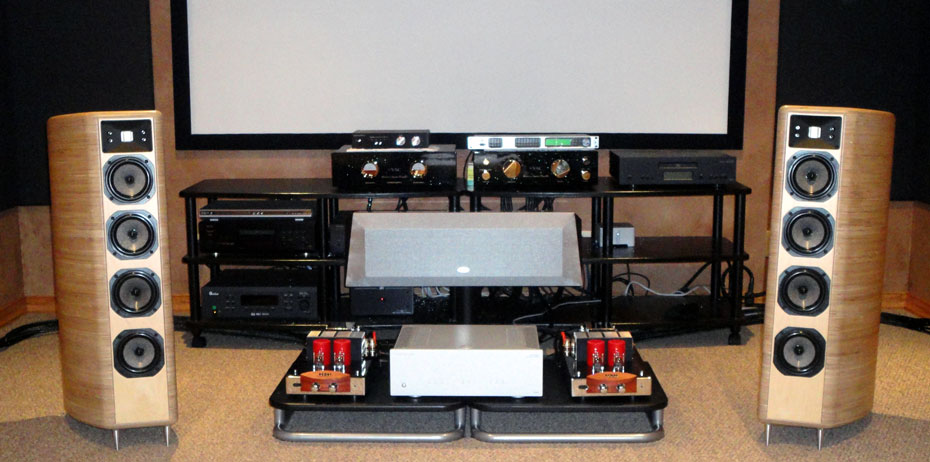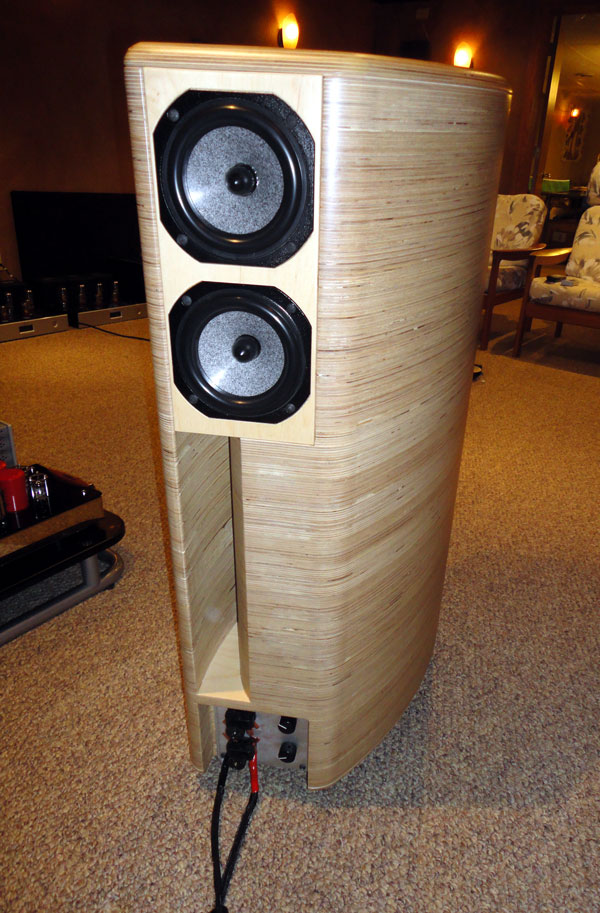The “Tower Monitor”
This leads me to a discussion of the concept of a floor standing monitor. Are you familiar with the phrases “Tower Monitor” or “Floor Standing Monitor”? Likely not, as the idea is an oxymoron and these are phrases I made up. Curious to see if anyone had implemented the idea, my search online yielded a Monitor series (defunct) of speakers by Polk which included both bookshelf and floor standing variety sans line array, and a floor standing group of speakers by Monitor Audio. What I did not find was the application of line arrays in two-way speakers with limited low frequency response and diminutive cabinets, yet too large to place on stands – precisely the type of speaker as the Ebb. So, perhaps I’m onto something when I consider the Ebb to be a Tower Monitor! The array of smaller bass drivers stretches the cabinet eliminating the possibility of placement on stands. Several of the performance characteristics of the Ebb more closely mirror a fine monitor than a big floor stander, a bookshelf with better quality bass.
The Ebb revealed its characteristics as a floor standing monitor readily enough as I put it through a series of song samples. Enhanced bass, that is bass with far more reinforcement than a typical small monitor with a single 5- to 6-inch bass driver, was evident especially when playing pieces with synthesized or electric bass. Among the artists who compose synthesized music, I enjoy that of Mars Lasar. While some of his work is monotonous I particularly enjoy “Against All Odds” and “Global Force” from his Final Frontier. Both have a militaristic feel with a strong, driving beat and noble trumpet-like melody. Even the Warfedale Opus 2-M2 with its 8-inch bass driver was unable to generate as much solidity to the bass as the array of 5-inch Focal drivers.
A distinct advantage was gained in the bass response when I determined to place the speakers in an unorthodox position. Seeing as the rear port followed the contour of the cabinet, pointing in the opposite direction from the angle of the front baffle, I determined to switch the left and right speakers to gain more involvement of the side walls from the port. Once switched, the speakers had to be flared outward to a radical degree. This swung the back end of the speaker, and the port, far closer to the side wall. It was visually shocking, as the backward tilt of the speaker combined with the curvature of the cabinet made it appear as though it would topple over at any moment. I checked the stability of the speakers several times to assure myself they were not going to go over if I happened to brush past them. However, once at ease with it the flared position was a refreshing alternative to the mundane straight ahead positioning of countless speakers. If the Strata finish will not elicit surprise from guests, the flared positioning surely will!
The effect was very pleasing in that the bottom-end now more readily filled the room and was not absorbed to the degree it was when the ports fired toward the sound panels at the head wall. I did not sense additional resonance or unwanted reflections off of materials like drywall. Perhaps this is due to the extreme construction of the room since it was built with studs 16 inches on center and the insulated walls have triple the normal number of drywall screws. I have neverhad room resonances no matter the subs used nor the size of the main speakers. With a flimsy wall perhaps the effect might not be so pleasing, but one should try it as the potential benefit is cost free and sonically not insignificant. I used the speakers in this “flared” position the remainder of the review period.
Extra Drivers, Extra Intensity
In trying to envision the additional heft or backing that an array of drivers carries versus a single bass driver, consider a perfectly synchronized tap dance troupe. With each additional dancer the intensity of the tapping is reinforced. I recall being impressed as a younger NDWM (Non-Dancing White Male) with the tap scenes in White Nights (1985)featuring Mikhail Baryshnikov and Gregory Hines. As marvelously in sync as tap dancers are, it pales in comparison to the synchrony with which an array plays. One finds it nearly impossible to distinguish individual drivers; rather, the combined surface of the drivers lends a sense of largeness from a small package. This is so despite the limited low frequency extension of the Ebb. In this respect it shows itself as more akin to a monitor than a floor standing speaker. It needs to make up in impact for what it lacks in extension, and does a fine job of fooling the mind into sensing it’s a bigger speaker.
As the array continues into the midrange it captures some of the nuances achieved with extremely high-end speakers, like the Nearfield Acoustics Pipedreams. Arrays stretch the center image to be taller than any traditional B/M/T can produce. The result is quite sizable; some audiophiles hold it in contempt describing it with disdain: “I don’t like hearing a five-foot head singing.” Indeed, one should hear an array to determine if the extended size of the center image is appealing. However, in one respect the Ebb has an advantage utilizing this technology – it is a smaller array which is not extremely tall. Consequently, it will not loft the vocals into the attic. Even when the speaker has its front baffle elevated, the performance stays grounded in reality.
Comparing the King Sound King ESL’s fully 6-foot array of mid/tweeter drivers to the nearly half sized Ebb, the difference in scale of the center image is immediately evident. The King cannot go small in terms of representing a voice or solo instrument; if it carried an attitude it would be, “Go big or go home!” When I play the music of big venue artists like U2 or massive orchestrations, the King generates the vastness of the musical space like few other speakers. But when a vocalist like Adele intimates her hurts in “Someone Like You”, it’s wrecked for some listeners when her voice emerges in wall-to-ceiling form. Not for me, but that’s what makes for variety in audiophilia.
One reason I do not mind this “exploded” form of a vocal or solo instrument is that it is opened up, sonically laid open in a fashion that I have not heard from any point source speaker. Lips parting, nearly silent sighs, modulation of the held note reveal that there is far more going on in a song than many ever hear through a sound system. Hearing a voice or instrument in such a fashion makes me feel that I am glimpsing the inner mysteries of an artist’s work, like a flower in full bloom exposed to the world.
This is one reason why the Raven tweeter endears itself to me. It has the ability to be alternatingly silky smooth or scapula sharp – sometimes in oxymoronic fashion both at the same time. The Ebb’s ribbon tweeter lends some degree of extension to the center image through issuance of distinct clues to the room boundaries, its height and width. This is greatly enhanced by use of the shorter spikes in the back causing an effective backward slant on the front baffle. Along with the wider wave guide the upward tilt causes the Ebb to mimic the expansiveness of an ESL, albeit to a lesser degree. This allows the Ebb to escape the narrow center image confines of a smaller stand mounted speaker and participate in the “laying open” process just described.
In the case of Adele’s “Someone Like You”, the Ebb, powered by erudite amplification like the VAC Signature MkII preamplifier and Phi 200 amplifier, exposes the soft clacking sound in the chorus as hand claps. The Ebb has refinement enough to hint at the sparse acoustic environment in which “21” was recorded, Adele’s home. Her voice is clean, the instruments slightly “crude” sounding, without the benefit of an ideal acoustic space. The less-than-perfect recording chamber is betrayed through a persistent brittleness to the sounds of the echoes reverberating off the walls. This gives the entire recording a slightly honest but unrefined feel, reminiscent of older jazz recordings.
Now There’s An In-Between Option
New technologies like the Orca Design tweeter and implementation of them as found in the Raven Studio Ebb yield surprising but practical products. Who would have thought ten years ago that the preference for the predominant personal computing device would veer strongly toward a tablet, or that one might store their active listening library on a phone? Similarly, it can be difficult to predict the movement of the masses in terms of tastes when it comes to high fidelity sound. One thing I’m seeing a lot more interest in is the DAC as a component, likely a result of the movement in listeners to streaming and file based sources. Another trend is the uptick in demand for décor-friendly speakers of not merely passable but excellent sound.
To that end the Ebb fits a growing niche, that of urban, techno savvy listeners who shop with environmental and lifestyle considerations in mind. I can imagine them pairing the Ebb with a Class D amplifier and spinning vinyl in a “what’s currently hot?” form of audiophilic passion. They will love the way it looks and the way it is a space-saver but doesn’t hand away all of big speaker sound. It will be their option in between invisible architectural speakers and obnoxious room engulfing boxes, their tower monitor.
- ← Previous page
- (Page 3 of 3)



I want to see compared this to a Heil Blue Ox AMT tweeter, nothing sounds better, lets see how the Raven tweeter compares.